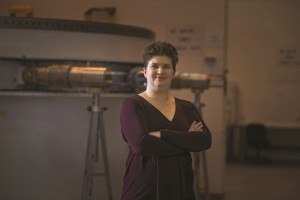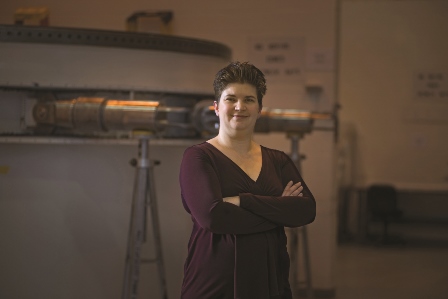‘There’s nothing like the excitement of a solid rocket motor static test,’ says Alicia Carrillo ’00. The anticipation, preparation, final countdown, and sense of accomplishment in the control bunker make it worth it every time.’
Carrillo, a Mines chemical engineering graduate, oversaw plenty of those tests during her tenure as chief engineer for the Space Launch System rocket. The massive booster, SLS for short, is being developed as the launch module for the Orion space capsule, which may someday carry astronauts to Mars.
But Carrillo won’t be in the command center for SLS’s first unmanned test launch in 2018. She recently accepted a new position as an R&D manager at Orbital ATK, the contractor that’s developing the SLS for NASA. How will she feel when the rocket finally blasts skyward? ‘It will be bittersweet,’ Carrillo says. ‘I worked on SLS from its inception, and I’ve worked on the Mars mission since the very beginning.’
Three years before its first voyage, the SLS has already traveled quite a distance. It began as a ‘heritage derivative’ project, says Carrillo, cobbled together out of parts salvaged from the booster rocket used in the space shuttle program. ‘The first thing we were told was, ‘All your parts are broken,’ she says. ‘These are components that splashed into the ocean. NASA would send divers out to retrieve those pieces, do a post-flight inspection, and refurbish the parts. We’re literally using that same hardware.’

Alicia Carrillo �00, a Mines chemical engineering graduate. (Courtesy of Alicia Carrillo)
Few events put material under stresses as intense as those associated with a rocket blastoff. In addition to extraordinary loads and oscillations, the components have to survive extreme heat as the engine ignites, followed almost immediately by extreme cold as the vessel enters the vacuum of space. ‘When we started, we had to work with 200 parts that were considered broken,’ Carrillo says. ‘We made minor modifications to some, we analyzed others with greater fidelity, and some we simply designed around.’ In the end, the team finished with only eight parts that needed to be redesigned.
Carrillo says the challenges posed by the SLS project reminded her of experiences in her Engineering Practices Introductory Courses (EPICs) at Mines. Those classes, she recalls, taught her to take a creative approach to complex problems. ‘In those courses, you just get thrown into it,’ she says. ‘What sets people apart is being able to bring a positive attitude to solving problems, as opposed to being overwhelmed. Taking something difficult, breaking it down, attacking the pieces you can attack, and working toward a solution that’s the preparation you get at Mines.’
Carrillo recounts an EPICs assignment in which her team had to develop a mechanical system for loading and unloading spools in a manufacturing process. She says she didn’t even know where to begin. The task fell way outside her comfort zone, but Carrillo muddled through. That type of experience, she says, helped her develop the self-confidence to take on daunting projects like the SLS even to enjoy them and seek them out. ‘There is an enormous variety of topics and challenges associated with the integration of an entire booster,’ says Carrillo of the SLS project. ‘We’re integrating the motor, the avionics, the safety systems, and then putting it together to make sure that it all works.’
Carrillo was recruited by Orbital ATK at a Mines job fair. The Salt Lake City-based company employs so many Mines alumni that Carrillo refers to it as ‘Mines West.’ While she didn’t want to leave the Mars program, the new job offered possibilities that were too exciting to pass up. As R&D manager for inert materials, she will enjoy an even greater variety of tasks than on the SLS team. ‘I’m changing from one big program to lots of little programs,’ she says. ‘Our R&D lab supports commercial and strategic projects, as well as the NASA program.’
The R&D lab will conduct occasional tests on materials for the SLS, so Carrillo will stay tangentially involved in the project. If all goes according to plan, the rocket’s initial launch will be quickly followed by the first manned SLS launch, and then, sometime in the 2020s, the first trips beyond earth orbit. ‘The first mission will probably be what’s called Asteroid Redirect,’ says Carrillo. ‘Find an asteroid out there, haul it into lunar orbit, and then land astronauts on it to study it.’
The hoped-for Mars mission likely won’t happen before the 2030s, but Carrillo will always feel like part of the team. ‘I want it to succeed,’ she says. ‘I might even have to make it down to Florida for that first launch in 2018.’



